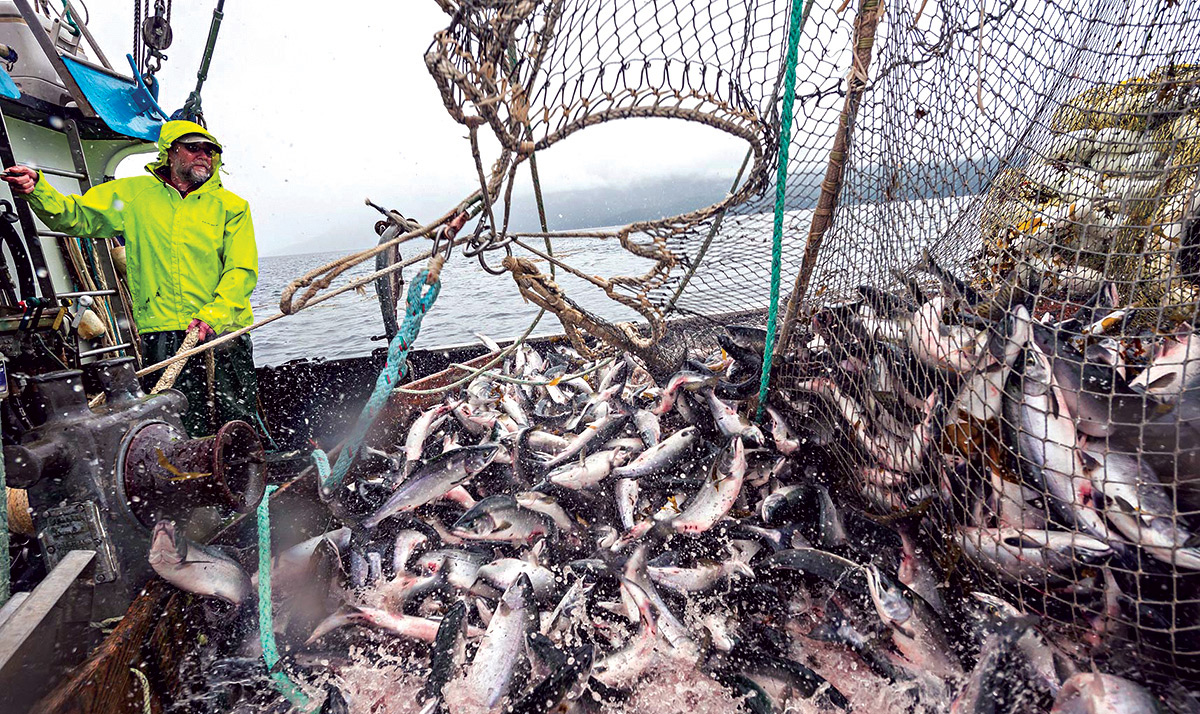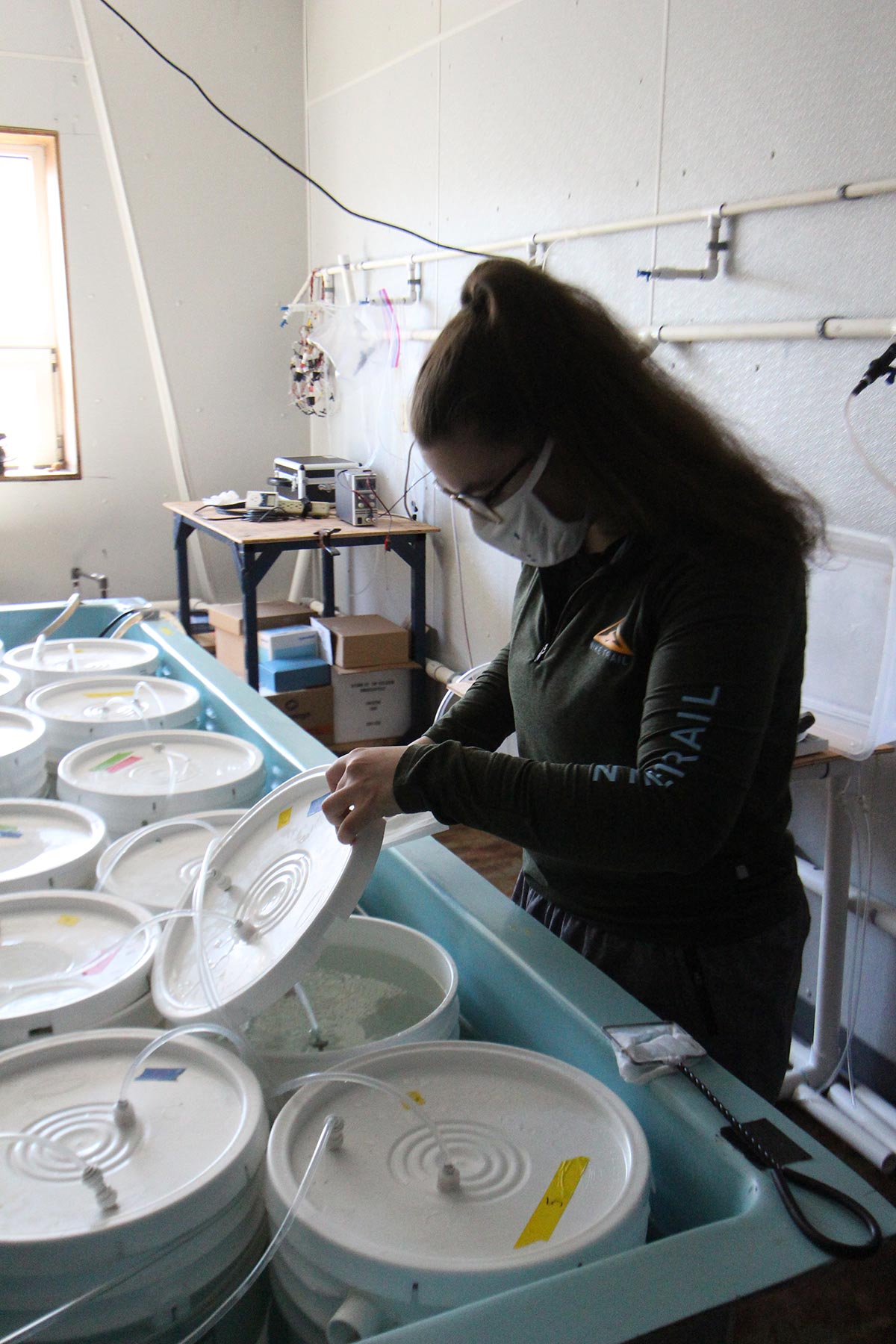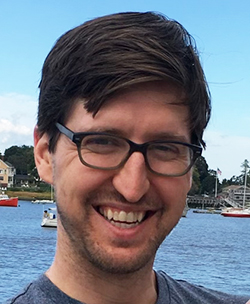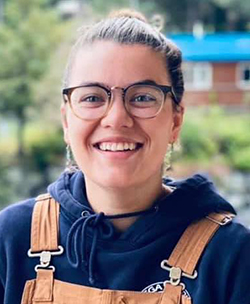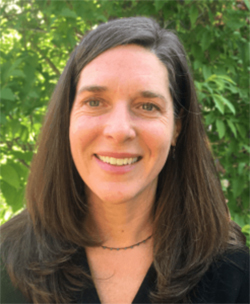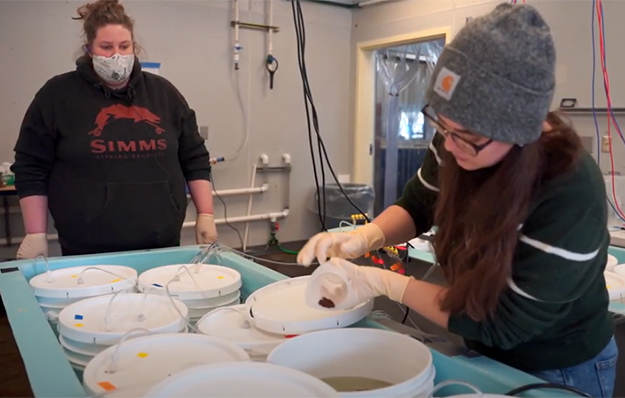 Salmon
Salmon
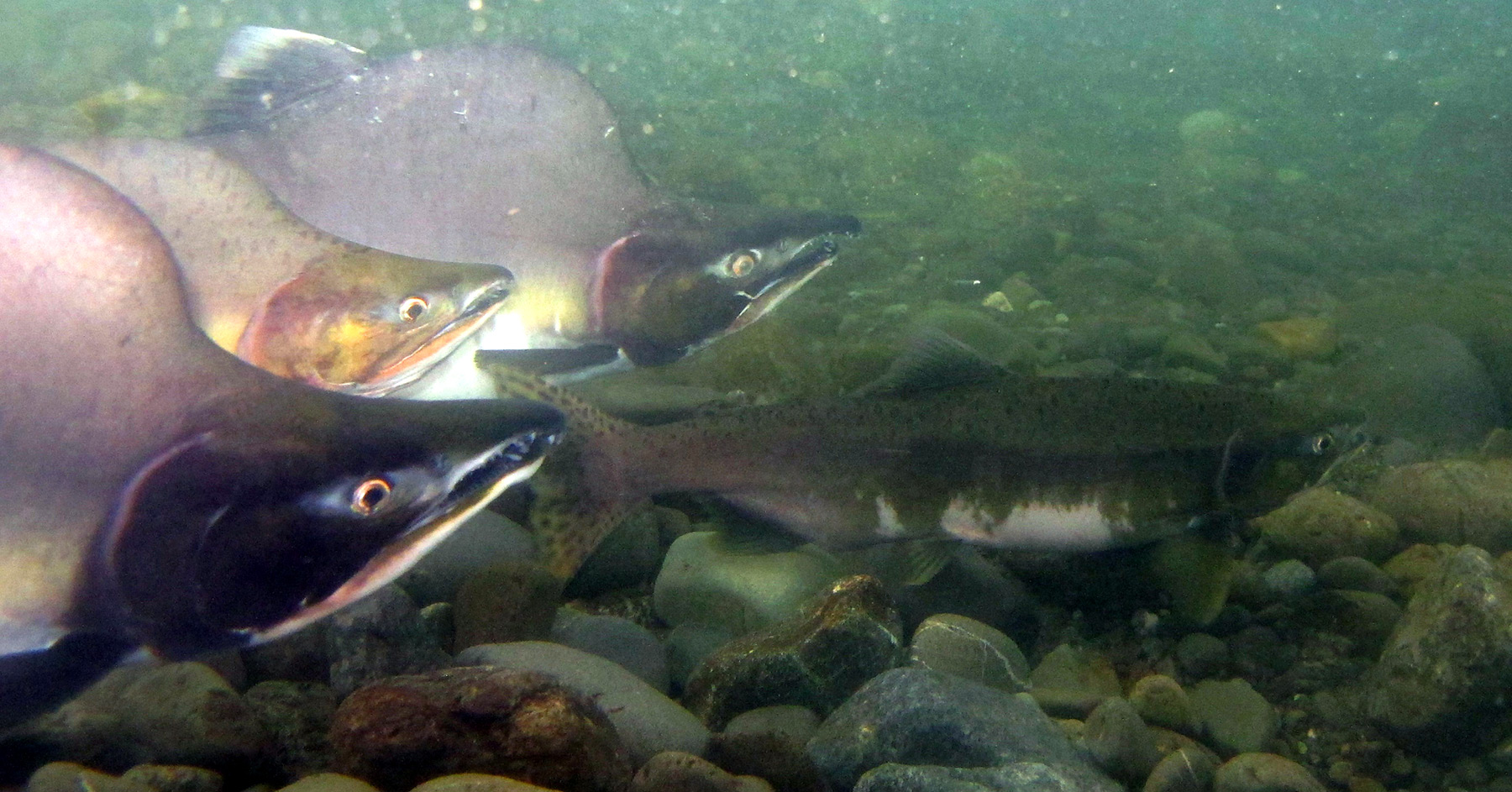
Spawning pink salmon. Photo by USFWS-Katrina-Mueller.
What We Know
Initial studies on coho salmon found that juvenile marine phase coho salmon no longer avoided the scent of predators when exposed to elevated CO2 for two weeks. This change in behavior was likely driven by changes in how important odor signaling was processed in their brains, resulting in an altered perception of what the salmon were smelling and how to respond. The scientific consensus is that this altered perception is the result of the salmon’s need to actively buffer their blood to the changing external pH of the seawater.
Fortunately, this research also showed that even though coho salmon experienced significant and negative effects in acidic waters, they were able to fully recover in less acidic water as soon as six hours after an exposure. This tells us that salmon are highly adaptable.
Research regarding the impact of ocean acidification on pink salmon is still in its early stages. Recent experiments found ocean acidification decreases the maximum metabolic rate, growth and overall health of juvenile pink salmon. This may negatively affect pink salmon during their transition from freshwater to saltwater as juveniles, making them more vulnerable to predation during that time. However, there is also the potential for certain populations to acclimate to an acidifying ocean. Evidence suggests that certain populations may be able to adjust their physiology to cope with acidic conditions over many generations. However, researchers don’t know how long it would take pink salmon to build a tolerance to elevated CO2 in later generations, and it remains to be seen if other species of salmon could possibly develop similar resistance.
Pink salmon may also be impacted by food web implications of ocean acidification. Pteropods, a free-swimming sea snail, are particularly susceptible to changes in acidity and have already shown degradation in the Gulf of Alaska and Bering Sea. Pteropods make up a significant portion of the diet of pink salmon when at sea. You can read more on the pteropods page.
Meet the Salmon
Salmon are ray-finned fish that hatch in freshwater, migrate to the open ocean, and return to their birthplace to spawn in freshwater and end their life cycle. Wild salmon is one of the most nutritious animal proteins and is prized around the world as a rich source of Omega-3 fatty acids and protein. Alaska is home to seven species of Pacific salmon that are commercially and recreationally important to the state economy. Salmon are also an important element of Alaska Native culture, spirituality, and the traditional subsistence diet and way of life.
Alaska is home to five species of Pacific salmon: chinook, coho, chum, sockeye, and pink. Salmon are also an important element of Alaska’s cultural, spiritual, commercial, recreational, subsistence traditions, harvests, and sharing. Of the species found in Alaskan waters, ocean acidification research has focused on coho (silver) and pink (humpy) salmon to date.
Photo Gallery
↓Click to enlarge↓
Recent Studies
NOAA recently funded an interdisciplinary project to investigate the implication of ocean acidification thresholds and major ecosystem shifts in the Gulf of Alaska as they relate to pink salmon and to inform salmon management decisions. The project involves both a review of historical data, modeling, and lab experiments. So far, data and modeling efforts in Prince William Sound show that ocean acidification has not yet played a statistically significant role in pink salmon population numbers, but this is likely to change in the future as ocean chemistry continues to change and fish are faced with multiple stressors. Learn about the Tipping Points project.
As part of the project, the Kelley Lab at the University of Alaska Fairbanks conducted research at the Alutiiq Pride Marine Institute in Seward to assess the response of juvenile pink salmon to ocean acidification and reduced food availability. The reduction in food level represents the predicted decline in certain zooplankton species that pink salmon utilize as a food resource under future OA conditions. This study also represents the longest culture of juvenile pink salmon under experimental conditions.
Results here showed that exposure to reduced pH conditions has a negative effect on the conditional index of juvenile salmon. Conditional index is a way to measure the overall health of a fish by comparing its weight with the typical weight of other fish of the same kind and same length. The results also showed that the combination of lower acidity water and reduced food resulted in lower growth rates for juveniles. Next steps for this research include looking more closely at this data as well as investigating the effect of ocean acidification on salmon otolith characteristics, cortisol expression, gene expression and metabolic rate. See a handout on lab study results.
Pink Salmon: Ohlberger et al. 2021
- Analysis focused on Prince William Sound using time series data on return abundances of wild pink salmon since the 1960s, hatchery releases of pink salmon, and ecological conditions in the ocean, including temperatures and proxies of ocean acidification
Results
- Potential negative effects of ocean acidification are not yet detectable in wild pink salmon, though these results are based on relatively short time series (1980–2013)
- Findings suggest non-stationary climate effects on ecosystem processes, specifically time-varying effects of environmental temperature on population productivity
- Evidence that large-scale production of hatchery reared pink salmon in Prince William Sound negatively affects the productivity of wild populations in this region
Pink Salmon: Frommel et al 2020
Pink Salmon: Frommel et al 2020
- Captured fish in Georgia Strait, British Columbia and transported them to a marine lab on Hakai Institute, Quadra Island where fish were exposed to one of three CO2 levels: 850, 1500 and 2000 μatm CO2, for 2 weeks
- At ½, 1 and 2 weeks of exposure, measured weight and length to calculate condition factor (Fulton’s K), as well as haematocrit and plasma [Cl−]
- At each of these times, two additional stressors were imposed: hypoxia and temperature
Results
- Juvenile pink salmon were largely robust to elevated CO2 concentrations up to 2000 μatm CO2, with no mortality or change in condition factor over the 2-week exposure duration.
- After 1 week of exposure, temperature and hypoxia tolerance were significantly reduced in high CO2, an effect that did not persist to 2 weeks of exposure.
- Haematocrit was increased by 20% after 2 weeks in the CO2 treatments relative to the initial measurements, while plasma [Cl−] was not significantly different.
- Taken together, these data indicate that juvenile pink salmon are quite resilient to naturally occurring high CO2 levels during their ocean outmigration.
Coho Salmon: Williams et al. 2019
Coho Salmon: Williams et al. 2019
- Coho salmon were offspring of spawned adults in the Washington Department of Fish and Wildlife’s Issaquah Creek Hatchery
- Exposures to CO2 levels of ambient (700uatm), medium (1600uatm), and high (2700uatm) for 14 days
- Examined salmon behaviors at different CO2 levels
Results
- Salmon in ambient state avoided alarm odor and explored the maze.
- Salmon in medium and high levels did not avoid alarm odor and had reduced exploration of the maze.
- Increased CO2 levels decreased gene expression of genes linked to neurotransmitter function.
- Increased CO2 led to increased gene expression of melatonin.
- Elevated CO2 levels disrupted neural signaling pathways for olfactory bulb.
- The response of nerves in the nose and brain showed that salmon’s noses function normally under more acidic conditions, but the way their brains process the scent was impaired.
Pink Salmon: Munday 2015 (review of Ou et al 2015)
Pink Salmon: Munday 2015 (review of Ou et al 2015)
- Embryos and juvenile pink salmon were reared in tanks for 10-weeks: ambient (450 uatm), high CO2 (1,000 and 2,000 uatm), and an oscillating 450 – 2,000 uatm)
Results
- Percentage of yolk converted to tissue was lower in high CO2 during freshwater stage. Fish were therefore lighter and smaller.
- High CO2 exposed fish were bolder and spent more time in water that were subject to alarm cues.
- Freshwater juvenile fish reared in high CO2 were less likely to engage in predator avoidance.
- Effects of high CO2 on growth in seawater were more pronounced, that is growth was negative and fish lost weight. Fish in ambient conditions grew substantially.
- Exposure to high CO2 in freshwater and seawater, effects were compounded. Lost weight at double the rate of fish only exposed to high CO2 in seawater.
- Maximum capacity for O2 uptake was 30% lower for fish exposed to high CO2 in seawater.
Implications
For Alaskans dependent on salmon, understanding how they may fare in a higher-acidity environment and the cultural and economic implications of their response, is critical. Formally evaluating the risks of ocean acidification and other thresholds to salmon fisheries, and assessing the benefits of pre-emptive human responses will be important for future decision making and adaptation. This is particularly important in Alaska, as the state’s constitution mandates salmon populations to be managed according to maximum sustainable yield. This provides less room for adaptive ecosystem-based management approaches such as the response to major regime shifts in ocean conditions.
Social science research underway is assessing fishermen’s observations about the potential implications of changing salmon characteristics and behaviors. Ocean acidification researchers will continue to work with the fishing community to share information and work together on adaptation strategies. View Salmon and OA brochure.
Researchers
Stories
Jun 2021
AOOSonline

